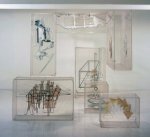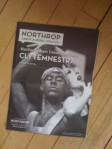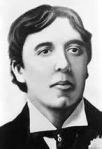Stage Beauty: The Walker’s acquisition of Cunningham sets
 During a recent theater tour, I was astounded to learn that much of the scenery painstakingly created for each new show (at least those with limited runs) is simply, and often by necessity due to space and storage limitations, trashed after the show closes. Certainly not every backdrop or flat, architectural staircase or balcony, chair or curtain is a masterpiece worth saving. Yet often, in dance anyway, such components of a stage performance are considered artworks—extremely valuable ones, at that—worthy of museum exhibition and conservation.
During a recent theater tour, I was astounded to learn that much of the scenery painstakingly created for each new show (at least those with limited runs) is simply, and often by necessity due to space and storage limitations, trashed after the show closes. Certainly not every backdrop or flat, architectural staircase or balcony, chair or curtain is a masterpiece worth saving. Yet often, in dance anyway, such components of a stage performance are considered artworks—extremely valuable ones, at that—worthy of museum exhibition and conservation.
Choreographer Ralph Lemon’s movement pieces with stunningly complex art objects by Nari Ward come to mind, as do dance artist Bill T. Jones’s collaborations with artist Keith Haring on sets. Of course the late-choreographer Merce Cunningham was the master and precedent-setter of collaborative methods based purely on chance, with score, movement, lighting, costumes and décor (as Cunningham called the visual art or sets on stage) created wholly independent of each other.
The components only came together on opening night, often after a roll of the dice determined the sequence of choreographic phrases for the dance portion of the work. Such “chance operations,” as Cunningham called this technique, freed the viewer’s imagination to conjure serendipitous connections between the components of a work.
Last week, the New York Times and then the Star Tribune announced that the Walker Art Center—which has long supported Cunningham’s choreographic works—is in the process of an important acquisition: upwards of 150 sets, costumes and art objects created for the Merce Cunningham Dance Company by such collaborators as Robert Rauschenberg and Jasper Johns.
If you’ve ever walked around Johns’ inflated plastic pillow-like structures for Cunningham’s “Walkaround Time” at the Walker, which are painted with images from Marcel Duchamp’s iconic “Bride Stripped Bare by Her Bachelors, Even,” you know the thrill of experiencing—up close and personal—the resonance of a remarkable “set” that’s appeared on stages around the world with arguably the most flawlessly articulate modern dancers in America.
The singular set also moves slightly with your breath and the air currents generated by other visitors walking by, creating a kinetic experience of art history. Duchamp was a long-time friend of Cunningham and John Cage (a composer and the choreographer’s lifetime collaborator and partner), which Johns (another Cunningham-Cage collaborator) celebrated in his transparent objects. Also encapsulated in this work are the artists’ infamous collaborative methods, integral to the development of modern and post-modern art and performance.
The Walker, as noted in the New York Times article on the acquisition, will use the collection to “experiment with bolder ways of integrating dance and performance into the world of object-based art.” Such de-siloing of the arts is what Cunningham, Cage and their collaborators were about, particularly as the traditionally rigid boundaries separately the disciplines of theater, dance and performance art continue to dissolve.
Among the stage works you’ve seen recently, whether “theater” or “concert dance,” which performances include “décor” worth saving? Should performance companies make a more concerted effort to save sets or scenery? If so, how might they accomplish such conservation efforts financially?
An Experiment in Criticism
In March and April, I’m the guest editor of Minnesota Playlist, and pretty much have free rein to do whatever I like. Minnesota Playlist does not publish previews or reviews. Still, when I proposed a series of perspectives (or reviews, if you will) on Aspen Santa Fe Ballet’s first Minnesota performance, written not by dance critics but rather by an architect, a playwright and a theater critic—with an audience-response audio segment created by one of my arts journalism students thrown in for fun—the package was a go.
As the contributors convened before, during and after the performance last Tuesday (March 8), which was part of the Northrop Dance Season but occurred at the State Theater in Minneapolis, everyone’s intrigue, excitement and even nervousness was palpable. My advice to those I talked into embarking on this adventure? Just have fun!
So today begins this experiment in critical perspectives, with contemporary ballet as our subject. No doubt many of you are wondering: Why? For several reasons, one of them being: Why not?
Dance and theater are often not-so-strange bedfellows. Movement and spatial configuration are integral components of staging, whether the art form occurring on stage is theater or dance, and choreography of various kinds is often incorporated into theatrical performances. Ballet as a genre found its footing in the French courts of the 17th century—under Louis XIV—as it broke away from opera and theatrical spectacle, and many ballets (the Romantic story ballets certainly) incorporate dramatic elements from sets and scenery to the singular telling gesture.
The body moving in space is also an integral component of good, useful architecture. I’ve written a lot about the correlations between architecture and dance, from the work of site-specific choreographers who originate movement specific to the historic structures in which the performance takes place, to architects (including Jean Nouvel, Zaha Hadid, Santiago Calatrava) who’ve created stage designs for dance performances (and sometimes theater, as well).
With that in mind, I was thrilled with Aspen Santa Fe Ballet’s opening piece, “Uneven,” because of its rigorous, intricate structure. The first U.S. work by Spanish choreographer Cayetano Soto, set to music by David Lang, with cellist Kimberly Patterson performing live on stage, “Uneven” is a study in rapid geometry with an almost feral quality. The piece is an architecture of lines and angles by which the dancers fold and unfold their limbs and torsos across, around and against each other with extreme flexibility and articulation, as if origami-like prototypes of post-human athletes. What will architect Phillip Koski write about this bold, sexy piece, performed with absolute certainty?
Or what will playwright Tom Poole make of “In Hidden Seconds,” choreographed by Nicolo Fonte, with its soft melancholic feel, and circular momentum? Or the work’s slated black-fabric curtain, through which the dancers emerge and retreat to John Tavener’s lush string score?
“Red Sweet,” the young, fresh company’s signature work choreographed by Jorma Elo to music by Vivaldi and Heinrich Biber, is a luscious, intriguing piece full of playful gestural detail and smart inventive partnering. At times grounded and fluttery, at other moments buoyant with fleet footwork and breathtaking lifts, “Red Sweet” is a “theatrical” work in its use of mime, action/reaction, and other communicative movements that remain humorously quirky, never gimmicky.
Theater critic Ed Huyck may have other ideas about “Red Sweet” and the overall program, which I’m eager to read. And my student Cristeta Boarini has compiled her interviews with audience members–including a schoolgirl, a high-school senior and two long-time dance patrons—into an audio document that takes the “man on the street” perspective to a new level.
Those are my thoughts and impressions, anyway, as a dance critic. Please check Minnesota Playlist over the next few days to read or listen to the insights and perspectives the contributors submit for this prismatic experiment in critic
Of Programs and Archives
 After a theater performance recently, as the applause died down and we began collecting our belongings, a friend who had accompanied me said, “Are you recycling your program? Oh, that’s right: You always keep your programs because you’re a critic.” Which led me to thinking. Why do I keep the paper programs from the theater, dance, opera, music and other performances I attend?
After a theater performance recently, as the applause died down and we began collecting our belongings, a friend who had accompanied me said, “Are you recycling your program? Oh, that’s right: You always keep your programs because you’re a critic.” Which led me to thinking. Why do I keep the paper programs from the theater, dance, opera, music and other performances I attend?
Sure, they’re a necessary reference while crafting a review, particularly for the names of the costume or lighting designers, the music list, or an obscure but helpful bit of bio. But I also keep programs from performances not reviewed. And things are getting a bit out of hand.
Scattered around the basement are bulging envelopes bursting with programs from years, even decades past. In the wood file cabinet next to my desk, the half a drawer allocated to programs is overflowing with paper; sometimes bits of programs even migrate to other drawers…yes, it’s a mess.
“But I might need to reference a program someday,” is my plaintive response to my own question: Why are you keeping this stuff? So until performance companies start downloading their programs to my iPhone as soon as my tickets are confirmed (is anyone doing this yet? Hint, hint), I’m going to continue keeping my programs and stuffing them into drawers.
Unless, of course, I get organized and donate all the old programs and press kits, along with the thousands of reviews, previews, features, news items articles and other articles I’ve written, to the Performing Arts Archives at the University of Minnesota.
The archives, which are located in the Andersen Library next to the law school on the West Bank, came to my attention in 2009 as I was writing an article on the exhibition, “Houlton’s Legacy: The Magic of Dance,” on view in the Anderson Library Gallery. The exhibition was created from material on Minnesota Dance Theater—photographs, costumes, articles, founder Loyce Houlton’s drafts of her autobiography; much of it rescued from a dumpster and given to the archives for safe keeping.
I met with then-curator Deborah Ultan Boudewyns, who asked me to look through the archived material and help identify people, places and dance works. Houlton’s era was before my time (although I remember her firing and MDT’s short-lived merger with Pacific Northwest Ballet), so I could only provide the name of a rehearsal space in one photograph and the title of a dance work in another.
Nonetheless, as Boudewyns and I worked carefully through piles of fragile materials, I marveled at how bits and pieces of a creative life could spark recognition and conjure memory. During the opening reception for the exhibition a few weeks later, Gary Peterson (now executive director of the Southern Theater) whispered that I really needed to gather all of my materials together—which would, in effect, provide a historical perspective on the past 20 years of dance in the Twin Cities—and that he was going to begin bothering me to ensure I did so.
Well…still not done. Sorry, Gary. But the archives of New Dance Ensemble (the Merce Cunningham-inspired company, co-founded by Linda Shapiro and Leigh Dillard in the 1990s, on which I cut my teeth as a critic), have been submitted. Materials from James Sewell Ballet and JAZZDANCE by Danny Buraczeski are in the archives, as well as the papers of Gertrude Lippincott (a choreographer and dance educator).
The archive also includes materials from the Guthrie Theater and At the Foot of the Mountain; and the papers of theater director, writer, and administrator Robert Corrigan, and of playwright Frederick Gaines. The Minnesota Orchestra and various scenic backdrops are also part of the archives, along with film posters.
So, what’s holding me back? My reluctance to just dump boxes of musty, mildew-y paper on the gracious, diligent staff of the archives: I really should organize it all first. And the fact that, well, I’m not done yet. Who knows what I’ll be doing, writing about, reviewing, editing in the next 20 years.
But that doesn’t mean you shouldn’t pull your archives together and submit them. The staff at the Performing Arts Archives would love to hear from you.
Of Were-Swans and Automatons: The Enduring Mystique of “Swan Lake”
I rarely write previews anymore, but couldn’t resist crafting this essay, The Enduring Mystique of “Swan Lake,” for mnartists.org.
The article “previews” a performance of “Swan Lake” by the Voronezh State Ballet Theatre of Russia (this Thursday evening at Northrop) while talking about the idea of transformation in “Black Swan.” Part of the essay actually comes from an abstract I submitted to the Popular Culture Association’s Science Fiction and Fantasy area, for a paper I’m presenting in April at the organization’s annual conference. I especially like (and appreciate) how my editor at mnartists.org hyperlinked to a video of Summer Glau–as the cyborg Cameron in “Terminator: The Sarah Connor Chronicles”–performing ballet as an example of cyborg ballerina: a topic I presented a paper on last year at the conference.
Here it is again: a segment which (as one of the comments says) would have made a perfect conclusion to this cinematic sci-fi show, with its visceral, agonizing and poignant theme of human-technological hybridity.
Enjoy!
Beck vs. Richardson, Opinion vs. Critical Thinking: How POV and the personal manifest in criticism
Last week my students were drafting and revising their first major writing assignment: a film review. During class, I presented them with various challenges in considering (and articulating) the different ways in which commentators (I hesitate to say journalists…you’ll know why in a moment) “review” (in this case, movies and theater).
I started class with this video excerpt: Glenn Beck (I know, I know…just hang on) bloviating on Julie Taymor’s Broadway debacle “Spiderman: Turn off the Dark,” from the Huffington Post. (scroll down to the second video)
Then I had them return to a review they’d read of “Black Swan” by Kartina Richardson, in which she takes a personal, almost scholarly, and unique approach to analyzing the dualities and multiples in the film, complete with screen shots like the one to the right:
The point of this exercise was to consider how each of these “reviewers” established a point of view; how each one addressed people with a different point of view; and how each expressed the personal in their review. i.e.: bluster versus articulation and explanation; opinion versus critical thinking.
At the same time, of course, I was subtly engaging the students in a dialogue about civility in public discourse, and in the value of self-awareness in being able to clearly substantiate an opinion…and in Richardson’s case, using another’s point of view as a jumping-off point for engaging, well-considered analysis.
We also discussed the evolution of film criticism in print and on television, especially with regard to the new “Ebert Presents at the Movies,” the latest iteration of the Ebert/Siskel/Roeper franchise, which debuted last week with Richardson as one of its commentators. Our reference texts: Ebert’s “Film Criticism is Dying? Not Online” and A.O. Scott’s “A Critic’s Place, Thumb and All.
My takeaway from these articles is Scott’s eloquent defensive of criticism and its value: “Criticism is a habit of mind, a discipline of writing, a way of life–a commitment to the independent, open-ended exploration of works of art in relation to one another and the world around them.”
Visual Arts: Recent Writing
Over the years I’ve covered visual art for Minnesota Magazine, mnartists.org, and various other publications. In late 2010, I was asked to write about the visual arts for City Pages. My assignments are largely A-List items (of about 200 words) on upcoming openings and exhibitions. It’s not criticism, but occasionally I’m asked to contribute a longer piece on a visual artist, which allows me greater freedom to bring my critical faculties to bear on their work. I love writing these mini-essays (which is how I think of them) because I challenge myself to intertwine my own perceptions of and opinions on an artist’s work with a bit of cultural context and (hopefully) some wit. Let me know what you think.
A sample:
Arts Criticism 2011

The Critic as Artist: “To the critic the work of art is simply a suggestion for a new work of his own, that need not necessarily bear any obvious resemblance to the thing it criticizes. The one characteristic of a beautiful form is that one can put into it whatever one wishes, and see in it whatever one chooses to see; and the Beauty, that gives to creation its universal and aesthetic element, makes the critic a creator in his turn, and whispers of a thousand different things which were not present in the mind of him who carved the statue or painted the panel or graved the gem.” — OSCAR WILDE 1890
In preparing my syllabus for a new semester of JOUR 4171 Covering the Arts: Backstage at the Guthrie Theater, I’ve decided to focus more firmly and thoroughly on criticism (reviewing the arts is always part of my curricula, but I feel a new urgency to intensify the critical thinking component). Here are some reasons:
* While teaching last semester, the boundaries between pr and journalism further dissolved before my eyes. Arts journalism is seemingly more concerned with entertaining and enticing (and sometimes educating) the consumer with previews (whether of blurb length (100-250 words) or 700-1000 word “advancers”), which is what I’m advocating arts organizations need to do via their own digital platforms as an integral part of their marketing and pr efforts. Already, media outlets produce such advance stories in order to solidify partnerships with arts organizations and secure their advertising. Arts organizations consider previews an essential part of their pr plans. The critic, meanwhile, an integral part of a community’s arts ecology, moves to the endangered list as fewer readers understand the differences between preview and review.
* A considerable portion of the arts-consuming public still wants, needs, craves arts criticism that’s clear and concise, provocative and well-substantiated, professionally crafted and contextual. (During a panel discussion on arts journalism sponsored by the Weisman Art Museum last year, we panelists were asked where to find arts criticism other than the lone voice at the Star Tribune. Go online, we emphasized over and over (!), citing such local resources as mnartists.org). At the same time, working arts journalists and educators, like myself, are charged with formulating a methodology for crafting and teaching arts criticism that encourages and empowers students to develop a point of view;substantiate it with description, interpretation, context and evaluation; and acquire the flexibility and adaptability to write (with a strong sense of style and voice) for a variety of media and word lengths.
So I was heartened after reading the Sunday New York Times Book Review, on January 2, which published a series of essays on literary criticism, one of which I’ll be using in my class: Katie Roiphe’s “With Clarity and Beauty, the Weight of Authority.”
Starting with a hilarious and self-effacing historical caveat about how we critics are always bemoaning the demise of critical thinking (so true!), Roiphe then confirms what my colleagues and I have repeatedly argued as our culture sags under the saturation of digital opinions, instantaneity, and the attention-grabbing proliferation of screens:
“If the critic has to compete with the seductions of Facebook, with shrewdly written television, with culturally relevant movies — with, in short, every bright thing that flies to the surface of the iPhone — that’s all the more reason for him to write dramatically, vividly, beautifully, to have, as Alfred Kazin wrote in 1960, a “sense of the age in his bones.” The critic could take all of this healthy competition, the challenge of dwindling review pages, the slash in pay, as a sign to be better, to be irreplaceable, to transcend.”
My heart leapt; my resolve quickened; my commitment to continually improve my own writing returned.
“….critics must strive to write stylishly, to concentrate on the excellent sentence. There is so much noise and screen clutter, there are so many Amazon reviewers and bloggers clamoring for attention, so many opinions and bitter misspelled rages, so much fawning ungrammatical love spewed into the ether, that the role of the true critic is actually quite simple: to write on a different level, to pay attention to the elements of style.”
So simple and so difficult.
As my students delve into writing from a critical (the meaning of which includes absolutely necessary or essential, as well as expressing or involving a detailed analysis of the merits and faults of a work of art) point of view, I’ll be advising, correcting, cajoling and questioning them as they strive to “write on a different level” than they’re used to reading or writing. To give Roiphe the last word:
“More than ever, critical authority comes from the power of the critic’s prose, the force and clarity of her language; it is in the art of writing itself that information and knowledge are carried, in the sentences themselves that literature is preserved. The secret function of the critic today is to write beautifully, and in so doing protect beautiful writing.”
Criticism? continued
Given the comments, thus far, to my last post, clearly the topic of arts criticism generates passionate responses, ranging from the financial power of critics to boost (or diminish) the monetary value of art to what exactly constitutes a work of art. Curiously, responses thus far are mostly from those concerned with the visual arts. Which brings to mind several conversations I’ve had lately about criticism (the topic on which, for now, these posts are focused).
Last week, Scott Stulen (visual artist and project director of mnartists.org) and Alan Berks (playwright and originator of mnplaylist.com) ended their visit to my class with this call: The Twin Cities needs a visual arts critic, with tough skin and well-honed critical abilities, to really address the work being created here. Artists may not like this person, but they’ll respect him/her.
I heard a similar call later in the week, while talking with two artists who are friends. The lack of thoughtful, well-substantiated criticism, they said, leads to mediocrity. This speaks to the belief that criticism is integral part of the art making, promoting, consuming and appreciating ecosystem. My questions are these:
What form should criticism take in the digital age? Meaning, what should the writing read like?
How do we critics negotiate the public’s hunger for entertainment and critical assessment, for the growing distaste for “elitist” critics (and what does that mean, anyway? That readers don’t like critics who know what they’re talking about?), and for access to arts criticism that creates thoughtful discourse?
As more critics migrate to pr, and pr takes on a more journalistic role (in terms of providing insights, education and in-depth access to artists, as my students did with our blog for the Southern Theater’s “Lush Life” show http://southernsongbook.tumblr.com/ ), where will criticism be published and who will write it?
I look forward to your comments.
Arts Criticism: Still Relevant or Passé?
The current relevance of arts criticism in contemporary culture is a thorny, complex topic that would take multiple posts to begin untangling and addressing. But here’s a start to an ongoing discussion.
During JOUR 4990 “Covering the Arts” this semester, we’ve been discussing whether arts criticism is still relevant to, necessary for or even wanted by readers. As we’ve discovered through our readings and guest speakers, most coverage of the arts (in Minnesota) is now promotional. Arts coverage–whether it’s via blogs, newspapers, magazines, tv or radio–appears primarily in advance of a show, exhibition or performance. Arts criticism is becoming more difficult to find; especially thoughtful, in-depth critical assessment.
We all know some of the reasons for this dearth of critical thinking and writing. Briefly: Newspapers have been laying off their long-time, full-time critics for a decade now; freelancers are picking up some of the slack, but many of them already have full-time positions in other professions–covering an arts discipline isn’t their primary job as it was for critics in the past. Some critics have migrated to online platforms, but again the work is freelance and the pay isn’t anywhere comparable to what professional critics had been paid. And so on.
With blogs, now everyone’s a critic (or rather, a reviewer as Rotten Tomatoes editor Matt Atchity explains in this video):
The democratization of opinion has merit, of course. But as one my students mentioned yesterday, the casual reviewer is more apt to give a thumbs up or thumbs down assessment of a show, while a seasoned critic is likely to discuss the art in cultural or historical contexts while relating that art to contemporary experience, thus “creating a discussion in your mind” or providing fodder for discourse with other interested people.
Then there’s the progressive dumbing down of our culture as entertainment and celebrity gossip take precedence over critical thinking about the arts. Apparently, this has even seeped into professional criticism. I asked my students: Is the manner or form in which criticism written relevant? “It’s huge!” was one enthusiastic reply. Her example: New York Times dance critic Alastair Macaulay’s sugarplum comment and the ensuring uproar. Read here for details:
http://www.guardian.co.uk/culture/charlottehigginsblog/2010/dec/07/alastair-macaulay-jenifer-ringer
As Charlotte Higgins writes in the above article, “It’s a tricky area, this: bodies, after all, are the material for the art form of dance and come under intense scrutiny. But there is a general agreement among critics that commenting on body shape is not done, unless it relates directly to the interpretation of the work.”
My students agreed, and their solution? The arts should have its own gossip columns, where such comments as Macaulay’s belong: “Jenifer Ringer, as the Sugar Plum Fairy, looked as if she’d eaten one sugar plum too many; and Jared Angle, as the Cavalier, seems to have been sampling half the Sweet realm.” According to my students, such remarks don’t belong in a “serious review,” which should focus on the work.
Thoughts? Let’s keep this discussion going.
Week of December 13
My students are busy working on their final projects–blogs and websites that fill a missing niche in local arts journalism, with an About section that articulates just what that niche is and whether they’re writing from a journalism or pr perspective (or integrating both), and with posts that demonstrate their critical thinking and writing skills. It’s the last week of the semester for classes!
Meanwhile, I’m still working on:
That Architecture Minnesota piece (on an Honor Award-winning project by HGA)
An artist profile/personal essay for City Pages
Next semester’s syllabus (for JOUR 4171: Covering the Arts, Backstage at the Guthrie Theater)
A few items for Ananya Dance Theater in preparation for a new show next year
A press release for a Wisconsin architecture firm
A post for this blog
Then, a break for the holidays!



